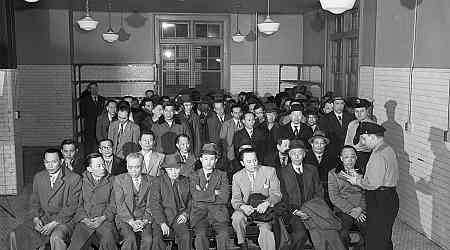
With intense political debate focused on the U.S. southern border, an unexpected trend has captured a great deal of attention. Chinese migrants are among the fastest growing national populations crossing the border, and their numbers have increased exponentially since 2022. In 2023, approximately 37,000 Chinese nationals entered the United States this way, compared to less than 2,000 the year before. In the first five months of 2024, over 24,000 Chinese migrants were apprehended on the Southern border. The journey over land through Mexico—or via a complex, multi-stop route that leaves them in Baja, Calif.—is not easy.
[time-brightcove not-tgx=”true”]But many migrants say they are motivated to undertake it because of the economic challenges facing middle-class Chinese citizens and small business owners in the wake of the COVID-19 pandemic and China’s strict Zero-COVID policy. Others highlight increasing political oppression, stemming both from increased monitoring of dissidents connected to Hong Kong or opposition movements as well as increased controls over public discourse since President Xi Jinping began his unprecedented third term in power.
In the United States, conservative media, think tanks, and politicians increasingly question these stated motives, expressing concerns instead that the Chinese Communist Party is “sending” migrants as spies, to form an army, or to otherwise sabotage U.S. national security.
None of this rhetoric about a Chinese “invasion” or “threat” is new. There is a long history of anti-Chinese and anti-Asian rhetoric in the United States. In the past, such rhetoric has led to violence and discrimination. Using it now—despite the lack of evidence that China or the CCP is using the border to “infiltrate” the country—threatens to stoke backlash against Chinese migrants and Asian Americans, as well as further damage the U.S. diplomatic relationship with China.
Read More: Florida Really Just Banned Chinese Immigrants from Owning Property. We’re Suing
Much of the early structure for policing U.S. borders and restricting immigration originated with a movement to restrict the arrival of Chinese laborers. In the 1870s, the growing number of Chinese immigrants entering the United States to earn money, working first in gold mining and then laying new railroads, faced increasing opposition from white workers concerned about competition driving down their own wages and working conditions.
Despite the relatively small numbers of Chinese immigrants, rhetoric focused on the effects of a Chinese “invasion” as well as a global narrative of a “yellow peril” that could result in Western countries being overrun by Chinese migrants intent on fundamentally transforming their cultures.
This rhetoric gave rise to the anti-Chinese movement in the American West, which translated into violent uprisings, shootings, and efforts to drive Chinese residents out of towns where they lived.
It also resulted in the federal Chinese Exclusion Acts, the first of which passed in 1882 to temporarily restrict the arrival of Chinese laborers. The measure was eventually made permanent by 1904, singling out the Chinese as the only people to be barred from entry on the basis of race, beyond admitting temporary residents on specific business, like diplomats, merchants, and students.
The Acts led to a decrease in the population of Chinese migrants already in the United States and prevented migrants from returning if they left to visit family in China. The Acts also stated that Chinese people could also not become naturalized American citizens, ensuring that those living in the U.S. would be cast as perpetual foreigners.
It was only during the Second World War that American impressions of the Chinese people gradually improved, when China was the “first to fight” against the Axis powers after the Japanese invasion. As a part of a larger series of measures aimed to aid China’s morale as a U.S. ally, the U.S. Congress repealed the Chinese Exclusion Act in 1943. For a brief period, Chinese immigrants to the United States were celebrated, though only accepted in small numbers thanks to the national origin quotas system put in place in the 1920s that curbed immigration from nearly everywhere but countries in Northwest Europe such as the United Kingdom.
The rise of Chinese communism and the victory of the CCP over Chiang Kai-shek’s nationalist government in 1949 led to renewed xenophobia and suspicion of Chinese residents in the United States. In the 1950s, reports of a uniquely Chinese method of illegal immigration based on claiming the identity of derivative citizens inflamed officials at the U.S. Departments of State and Justice. Visa screenings in Hong Kong for new migrants slowed even beyond the sluggish pace that had dominated the 1940s. The FBI launched a series of raids on benevolent organizations in U.S. Chinatowns, seeking their records to prove that many Chinese in the United States entered under false identities, which people had been forced to do having been singled out for exclusion since the 1880s.
Many Chinese Americans also were subjected to abuse, arrest, and FBI harassment, in addition to increasing suspicion from the American public.
Although in later decades of the Cold War, Chinese Americans would join Japanese Americans as a much touted “model minority” for their academic achievements—especially after immigration reform in 1965 removed the quota system and more migrants arrived from across the globe—this stereotype proved damaging.
Read More: One Year After Shooting, Monterey Park Celebrates Lunar New Year With Resilience
The assumption that Chinese Americans were unique and different from other ethnic groups in the United States kept the “perpetual foreigner” syndrome alive, allowing many Americans to assume that people of Chinese descent, citizens or not, would always remain more loyal to China than the United States.
This set of assumptions helped frame the devastating 1982 murder of young Chinese American Vincent Chin, whose identity was mistaken for that of a Japanese national by a pair of auto workers whose blamed Japan for their unemployment. Similarly false assumptions also led to the arrest and persecution of Taiwanese American scientist Wen Ho Lee. Lee had worked at the Los Alamos National Laboratory in New Mexico on systems connected to the U.S. nuclear arsenal.
When information about U.S. nuclear systems seemed to have been transferred to China, Lee was arrested and detained for over a year, mostly in solitary confinement. The evidence that Lee had spied for China never materialized, and he was ultimately released and won a civil settlement against the government and certain media entities for how they handled his case.
The assumption that Chinese Americans or Chinese migrants with access to technical and scientific information must be using it on behalf of China has not declined in the last three decades.
Since 2000, Chinese espionage in the United States has been significant, with Chinese nationals most often committing the crimes. However, this espionage has come most often in the form of hacking, cyber-attacks, and efforts to steal trade secrets from tech firms, undertaken both within and outside of U.S. territory. But there are no known examples of economic migrants entering the United States and engaging in espionage.
In 2018, the U.S. Department of Justice launched its “China Initiative,” seeking to uncover unlawful technology and scientific transfers to China, investigating ethnic Chinese professors and researchers in the United States and subjecting them to what was often unwarranted scrutiny. The program was ended in 2022 with the admission that it frequently targeted ethnic Chinese people and subjected them to suspicion and harassment without clear evidence that they had done anything wrong.

During the COVID-19 pandemic, some used rhetoric that linked Chinese migrants to the circulating virus. Derogatory language like “kung flu” and the “China virus” led to a well-documented increase in harassment, discrimination, and violence reported by Asian Americans. Connecting ethnic Chinese people in the United States to a pandemic that destroyed lives and livelihoods helped stoke assaults on Asian Americans, and it harked back to the Chinese exclusion era when migrants were blamed for outbreaks of the flu and other diseases. This led to a grassroots movement centered on the slogan “Stop Asian Hate” to raise awareness of crimes again Asian and Pacific Islander Americans.
Protecting U.S. national security is important, and immigration law and policy can play an important role in that. However, it is possible to manage even irregular entries on the Southern border without resorting to the language of “invasion” and peril that has done so much damage to Chinese immigrant and Chinese American communities in the past and present.
Meredith Oyen is an associate professor of history and director of the Asian Studies Program at the University of Maryland, Baltimore County. She is the author of The Diplomacy of Migration:
Transnational Lives and the Making of U.S.-Chinese Relations in the Cold War (Cornell University Press, 2015).
Made by History takes readers beyond the headlines with articles written and edited by professional historians. Learn more about Made by History at TIME here. Opinions expressed do not necessarily reflect the views of TIME editors.



























